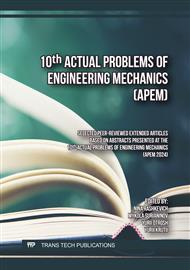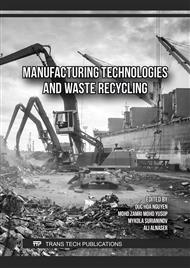[1]
«Eurostat regional yearbook 2020 edition» [Electronic resource] https://ec.europa.eu/eurostat/documents/3217494/11348978/KS-HA-20-001-EN-N.pdf
Google Scholar
[2]
S. Hryhoriev, A. Petryshchev, N. Sinyaeva, A. Yurchenko, O. Sklyar, S. Kvitka, V. Borysov, V. Vlasiuk, B. Tsymbal, S. Borysova, Studying the physicalchemical properties of alloyed metallurgical waste as secondary resourcesaving raw materials. Eastern-European Journal of Enterprise Technologies. 12 (2018) 43–48.
DOI: 10.15587/1729-4061.2018.140924
Google Scholar
[3]
Petryshchev, A., Milko, D., Borysov, V., Tsymbal, B., Hevko, I., Borysova, S., Semenchuk, A. (2019). Studying the physical-chemical transformations at resourcesaving reduction melting of chromenickelcontaining metallurgical waste. Eastern-European Journal of Enterprise Technologies. 2/12 (98) 59–64.
DOI: 10.15587/1729-4061.2019.160755
Google Scholar
[4]
V. Volokh, E. Kim, T. Fesenko, A. Petryshchev, S. Artemev, B. Tsymbal, L. Makarenko, A.Hedzyk, V. Slabko, V. Khmelovskyi, Identifying the features of structural and phase transformations in processing the waste of metallurgical products doped with refractory elements. Eastern-European Journal of Enterprise Technologies. 5/12 (2020) 32–38.
DOI: 10.15587/1729-4061.2020.214826
Google Scholar
[5]
Statistics: U.S. Percent Share of Selected World Nonfuel Mineral Production, [Electronic resource]. (2022), (1980-2021).
Google Scholar
[6]
M. Ahmaruzzaman, A review on the utilization of fly ash. Progress in Energy and Combustion Science. 3 (2010) 327–363.
DOI: 10.1016/j.pecs.2009.11.003
Google Scholar
[7]
S. Ragimov, V. Sobyna, S. Vambol, V. Vambol, A. Feshchenko, A. Zakora, E. Strejekurov, V. Shalomov, Physical modelling of changes in the energy impact on a worker taking into account high-temperature radiation. Journal of Achievements in Materials and Manufacturing Engineering. 91 1 (2018) 27–33.
DOI: 10.5604/01.3001.0012.9654
Google Scholar
[8]
D. Sokolov, V. Sobyna, S. Vambol, V. Vambol, Substantiation of the choice of the cutter material and method of its hardening, working under theaction of friction and cyclic loading. ArchivesofMaterialsScienceandEngineering. 94 2 (2018) 49–54.
DOI: 10.5604/01.3001.0012.8658
Google Scholar
[9]
V.M. Loboichenko, A.E., Vasyukov, T.S. Tishakova, Investigations of mineralization of water bodies on the example of river waters of Ukraine. Asian Journal of water, environment and pollution. 14(4) (2017) 37–41.
DOI: 10.3233/ajw-170035
Google Scholar
[10]
V. Loboichenko, V. Strelec, The natural waters and aqueous solutions express-identification as element of determination of possible emergency situation. Water and Energy International. l 61RNI 9 (2018) 43–50.
Google Scholar
[11]
B. Pospelov, V. Andronov, E. Rybka, O. Krainiukov, K. Karpets, O. Pirohov, I. Semenyshyna, R. Kapitan, A. Promska, O. Horbov, Development of the correlation method for operative detection of recurrent states. Eastern-European Journal of Enterprise. 6/4 (102) (2019) 39–46.
DOI: 10.15587/1729-4061.2019.187252
Google Scholar
[12]
B. Pospelov, E. Rybka, R. Meleshchenko, O. Krainiukov, S. Harbuz, Yu. Bezuhla, I. Morozov, A. Kuruch, O. Saliyenko, R. Vasylchenko, Use of uncertainty function for identification of hazardous states of atmospheric pollution vector. Eastern-European Journal of Enterprise. 2/10 (104) (2020) 6–12.
DOI: 10.15587/1729-4061.2020.200140
Google Scholar
[13]
Statistics: World Coal Production, Trade, and Demand. (2021) [Electronic resource] https://nma.org/wp-content/uploads/2022/10/int_coal_prod_trade_demand_2021.pdf
Google Scholar
[14]
US National Extractive Industries Association Analyst Report «Petroleum Overview» report for 2019 [Electronic resource].
Google Scholar
[15]
Statistics: U.S. Coal Production Trends, 1980-2021 [Electronic resource] https://nma.org/wp-content/uploads/2021/10/us_coal_production_trends_(2021)
Google Scholar
[16]
US National Extractive Industries Association Analyst Report «Coal Overview» report for 2019 [Electronic resource]. https://www.eia.gov/totalenergy/data/monthly/pdf/sec6_3.pdf
Google Scholar
[17]
A.M. Kasimov, N.I. Misyura, A.A. Kovalev, Migraciya tyazhelyh cvetnyh metallov v pochvah rajonov razmeshcheniya zoloshlakovyh otvalov ugol'nyh teplovyh elektrostancij. Ekologiya i promyshlennost'. 1 (2011) 96–99.
Google Scholar
[18]
R. C. Bhangare, M. Tiwari, P. Y. Ajmal, S. K. Sahu, G. G. Pandit, Distribution of natural radioactivity in coal and combustion residues of thermal power plants. Journal of Radioanalytical and Nuclear Chemistry. 300/1 (2014) 17–22.
DOI: 10.1007/s10967-014-2942-3
Google Scholar
[19]
Y. Danchenko, V. Andronov, E. Barabash, T. Obigenko, E. Rybka, R. Meleshchenko, A. Romin, Research of the intramolecular interactions and structure in epoxyamine composites with dispersed oxides. Eastern-European Journal of Enterprise Technologies. 6/12 (90) (2017) 4–12.
DOI: 10.15587/1729-4061.2017.118565
Google Scholar
[20]
V. Sadkovyi, B. Pospelov, V. Andronov, E. Rybka, O. Krainiukov, A. Rud, K. Karpets, Y. Bezuhla, Construction of a method for detecting arbitrary hazard pollutants in the atmospheric air based on the structural function of the current pollutant concentrations. Eastern-European Journal of Enterprise Technologies. 6 (10) (2020) 14–22.
DOI: 10.15587/1729-4061.2020.218714
Google Scholar
[21]
C. Heidrich, HJ Feuerborn, A. Weir, Coal combustion products – a global perspective VGB. Power Tech. 12 (2013) 46–52.
Google Scholar
[22]
Z. T. Yao, X. S. Ji, P. K. Sarker, J. H. Tang, L. Q. Ge, M. S. Xia, A comprehensive review on the applications of coal fly ash. Earth-Science Reviews. 141 (2015) 105–121.
DOI: 10.1016/j.earscirev.2014.11.016
Google Scholar
[23]
A.M. Kasimov, A.A. Kovalev, A.V. Povalyaeva, Utilizaciya othodov elektrostancij, rabotayushchih na tverdom i zhidkom toplive. Vostochno-Evropejskij zhurnal peredovyh tekhnologij. 4/8 (46) (2011) 15–20.
Google Scholar
[24]
O. Rybalova, S. Artemiev, W. Sarapina, B. Tsymbal, A. Bakhareva, O. Shestopalov, O. Filenko, Development of methods for estimating the environmental risk of degradation of the surface water state. Eastern-European Journal of Enterprise Technologies. 2/10–92 (2018) 4–17.
DOI: 10.15587/1729-4061.2018.127829
Google Scholar
[25]
«Ukraine in numbers in 2020» statistical collection – Kiev: State Committee of Statistics of Ukraine, (2021).
Google Scholar
[26]
S. Naganathan, N. Subramaniam, K. Nasharuddin bin Mustapha, Development of brick using thermal power plant bottom ash and fly ash. Asian journal of civil engineering (building and housing). 13/2 (2012) 275–287.
Google Scholar
[27]
T.I. Krasnenko, V.G. Bamburov, Optimization of the complex recycling of ash and slag from thermal power plants. Khimicheskaya Tekhnologiya. 11/6 (2010) 380–383.
Google Scholar
[28]
L.M. Delitsyn, A.S. Vlasov, The need of applying new approaches for using ash produced at coal-fired thermal power stations. Thermal Engineering. 57/4 (2010) 325–331.
DOI: 10.1134/s0040601510040087
Google Scholar
[29]
M. Liyanage, D. Jayaranjan, E. D. van Hullebusch, A. P. Annachhatre, Reuse options for coal fired power plant bottom ash and fly ash. Reviews in Environmental Science and Bio Technology. 13/4 (2014) 467–486.
DOI: 10.1007/s11157-014-9336-4
Google Scholar
[30]
H. Shi, M. Chertow, Y. Song, Developing country experience with eco-industrial parks: a case study of the Tianjin Economic-Technological Development Area in China. Journal of Cleaner Production. 18/3 (2010) 191–199.
DOI: 10.1016/j.jclepro.2009.10.002
Google Scholar
[31]
S. Vambol, V. Vambol, V. Sobyna, V. Koloskov, L. Poberezhna, Investigation of the energy efficiency of waste utilization technology, with considering the use of low-temperature separation of the resulting gas mixtures. Energetika. 64/4 (2018) 186–195.
DOI: 10.6001/energetika.v64i4.3893
Google Scholar
[32]
A. Q. Vilakazi, S. Ndlovu, L. Chipise, A. Shemi, The Recycling of Coal Fly Ash: A Review on Sustainable Developments and Economic Considerations. Sustainability. 14(4) (2022) 16–28.
DOI: 10.3390/su14041958
Google Scholar
[33]
A.M. Kasimov, A.A. Kovalev, Inovacionnaya tekhnologiya izvlecheniya vanadiya iz netradicionnogo vtorichnogo syr'ya. V Mіzhnarodna naukovo-praktichna konferencіya «Teorіya ta praktika virіshennya ekologіchnih problem v metalurgіjnіj ta gіrnicho-vidobuvnіj promislovostі» m. Dnіpropetrovs'k. (2011) 17–22.
Google Scholar
[34]
A.S. Meawad, Y. Darinka, B. Yoncho, G. Pelovski, An overview of metals recovery from thermal power plant solid wastes. Waste Management. 30/12 (2010) 2548–255.
DOI: 10.1016/j.wasman.2010.07.010
Google Scholar
[35]
D.B. Sarode, R.N. Jadhav, V.A. Khatik, Sopan Tukaram Ingle, Sanjay Baliram Attarde, Extraction and Leaching of Heavy Metals from Thermal Power Plant Fly Ash and Its Admixtures. Polish J. of Environ. Stud. 19/6 (2010) 1325–1330.
Google Scholar
[36]
H. Jammulamadaka, S.V. Pisupati, A Critical Review of Extraction Methods for Vanadium from Petcoke Ash. Fuels. 4 (2023) 58–74. https://doi.org/10.3390/ fuels4010005
DOI: 10.3390/fuels4010005
Google Scholar
[37]
R.C. Bhangare, P.Y. Ajmal, S.K. Sahu, G.G. Pandit, V.D. Puranik, Distribution of trace elements in coal and combustion residues from five thermal power plants in India. International Journal of Coal Geology. 86/4 (2011) 349–356.
DOI: 10.1016/j.coal.2011.03.008
Google Scholar
[38]
K.V. Goncharov, D.Yu. Kashekov, G.B. Sadykhov, T.V. Olyunina, Processing of fuel oil ash from thermal power plant with extraction of vanadium and nickel. Non-ferrous Metals. 1 (2020) 3–7.
DOI: 10.17580/nfm.2020.01.01
Google Scholar
[39]
O. Popov, A. Iatsyshyn, V. Kovach, V. Artemchuk, D. Taraduda, V. Sobyna, D. Sokolov, M. Dement, V. Hurkovskyi, K. Nikolaiev, T. Yatsyshyn, D. Dimitriieva, Physical features of pollutants spread in the air during the emergency at NPPs. Nuclear and Radiation Safety. 4/84 (2019) article no. 11.
DOI: 10.32918/nrs.2019.4(84).11
Google Scholar
[40]
V. Pilipenko, V. Kuprikov, A. Soznik, Microscopic nucleonnucleus optical potential with rearrangement effects based on the effective skyrme forces. International Journal of Modern Physics. 18/9 (2009) 1845–1862.
DOI: 10.1142/s0218301309013907
Google Scholar
[41]
B. Pospelov, V. Andronov, E. Rybka, O. Krainiukov, M. Maksymenko, R. Meleshchenko, Y. Bezuhla, I. Hrachova, R. Nesterenko, A. Shumilova, Mathematical model of determining a risk to the human health along with the detection of hazardous states of urban atmosphere pollution based on measuring the current concentrations of pollutants. Eastern-European Journal of Enterprise Technologies. 4/10 (2020) 37–44.
DOI: 10.15587/1729-4061.2020.210059
Google Scholar
[42]
S.Liu, L. Wang, J. Chen, L. Ye, J. Du, Research progress of vanadium extraction processes from vanadium slag: A review. Separation and Purification Technology. 342 21 (2024) 127035.
DOI: 10.1016/j.seppur.2024.127035
Google Scholar
[43]
P. Ning, X. Lin, X. Wang, H. Cao, High-efficient extraction of vanadium and its application in the utilization of the chromium-bearing vanadium slag. Chemical Engineering Journal. 301 (2016) 132–138.
DOI: 10.1016/j.cej.2016.03.066
Google Scholar
[44]
S. Liu, W. Xue, L. Wang, Extraction of the Rare Element Vanadium from Vanadium Containing, Materials by Chlorination Method: A Critical Review. Metals. 11/1301 (2021).
DOI: 10.3390/met11081301
Google Scholar
[45]
A. Kovalev, D. Wainstein, V. Vakhrushev, A. Volkov and U. Kologrieva, Features of the Microstructure and Chemical Compositions of Vanadium-Containing Slags Including Determination of Vanadium Oxidation. Degrees Materials. 12 (2019) 3578.
DOI: 10.3390/ma12213578
Google Scholar
[46]
W.C. Song, K. Li, Q. Zheng & H. Li, A Novel Process of Vanadium Extraction from Molten Vanadium Bearing Slag. Waste and Biomass Valorization. 5 (2014) 327–332.
DOI: 10.1007/s12649-013-9286-z
Google Scholar
[47]
J. Lee, E. Kim, K.W. Chung, R. Kim, H.S. Jeon, A review on the metallurgical recycling of vanadium from slags: towards a sustainable vanadium production. Journal of Materials Research and Technology. 12 (2021) 343–364.
DOI: 10.1016/j.jmrt.2021.02.065
Google Scholar
[48]
A. Petryshchev, N. Braginec, V. Borysov, V. Bratishko, O. Torubara, B. Tsymbal, S. Borysova, L. Lupinovich, A. Poliakov, V. Kuzmenko, Study into the structural-phase transformations accompanying the resource-saving technology of metallurgical waste processing. Eastern-European Journal of Enterprise Technologies. 4/12–100 (2019) 37–42.
DOI: 10.15587/1729-4061.2019.175914
Google Scholar
[49]
V. Vambol, Numerical integration of the process of cooling gas formed by thermal recycling of waste. Eastern-European Journal of Enterprise Technologies. 6/8 (84) (2016) 48–53.
DOI: 10.15587/1729-4061.2016.85455
Google Scholar
[50]
H.I. Gomes, A. Jones, M. Rogerson, G.M. Greenway, D.F. Lisbona, I.T. Burke, W.M. Mayes, Removal and recovery of vanadium from alkaline steel slag leachates with anion exchange resins. Journal of Environmental Management. 187 (2017) 384–392.
DOI: 10.1016/j.jenvman.2016.10.063
Google Scholar
[51]
H. Jammulamadaka, S.V. Pisupati, A Critical Review of Extraction Methods for Vanadium from Petcoke Ash. Fuels. 4(1) (2023) 58–74.
DOI: 10.3390/fuels4010005
Google Scholar



